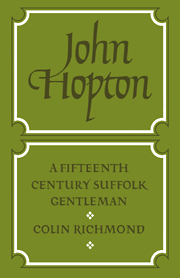1 - How John Hopton obtained his livelihood
Published online by Cambridge University Press: 30 October 2009
Summary
… for it is resonable a gentilman to know his pedegre and his possibilyte: seynt Poule foryete nat to write to the Romayns of what lynage he was descended, Ad Romanos xj.
Thomas Gate to Thomas Stonor, 5 October between 1460 and 1474 The Stonor Letters and Papers 1, p136‘A most interesting dinner. There was a M. de la Raspelière there who kept us spell-bound with his explanation of how that Mme de Saint-Loup with the pretty daughter is not really a Forcheville at all. It was as good as a novel.’
Marcel Proust, Remembrance of Things Past, vol 12 (Chatto and Windus paperback edition, 1967), p354John Hopton was a fortunate man. On 7 February 1430 the escheators of various counties were ordered to hand over to him numerous estates which had been found to be his by virtue of enfeoffments made some seventeen years previously by Sir Roger Swillington, the half-brother of John's father Thomas Hopton. Such a windfall was not entirely unexpected in 1430. Three years before, on 26 February 1427, in an indenture between Thomas Saville of Thornhill, Yorks, and the guardians of John Hopton (then styled John Swillington) for the marriage of Saville's daughter Margaret to John, mention was made of ‘what time of good fortune any of the reversions falle’. The young man clearly had good, albeit still unsettled, prospects.
- Type
- Chapter
- Information
- John Hopton: A Fifteenth Century Suffolk Gentleman , pp. 1 - 30Publisher: Cambridge University PressPrint publication year: 1981



